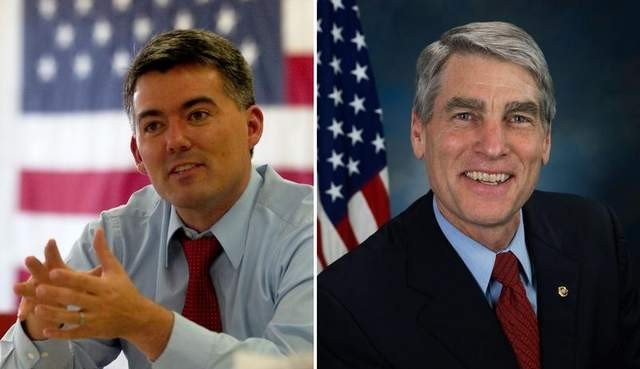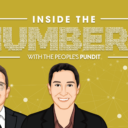

The PPD Colorado Senate race prediction moves to “Toss-Up” as Rep. Cory Gardner (left) proves to be a challenging roadblock for vulnerable incumbent Democratic Senator Mark Udall (right).
The Colorado Senate race is unrecognizable from the one described in a May, 2013, National Journal article entitled, “Colorado’s Forgotten Senate Race.” PPD’s election projection model has warranted two rating changes since the entrance of Rep. Cory Gardner in February, both of which clearly show this race slipping away from incumbent Democratic Senator Mark Udall.
In February, after Ken Buck made the decision to drop out of the race to make way for Gardner, a far more electable rising star in the GOP, we changed our Colorado Senate race rating from “Likely Democrat” to “Leans Democrat.” Now, after adjusting the variables used in our 2014 Senate Map Predictions model to reflect recent developments, we are once again changing the rating for this race.
“The incompetence of the Obama administration, the incompetence of Harry Reid’s leadership in the Senate has worn thin on the American people,” said Rob Collins, executive director of the National Republican Senatorial Committee. “So we just need to provide an alternative that says we can grow our economy, we can create more jobs, we can tackle this debt and we can fix ObamaCare.”
He has a valid point, according to recent surveys. But before we get to the recent polling, per se, let’s provide some data for context.
First, in Gallup’s annual party ID by-state survey, Colorado voters expressed a modest but notable shift in party preference toward the Republican Party. In an election likely to be decided on voter turnout, a few points in either direction can make all of the difference. When we look into the latest voter registration numbers and compare them to past election results, we can conclude Gallup correctly predicted this shift.
Since the 2012 presidential election, Democrats have added 28,008 voters to their voter registration roles, which totaled 915,475 voters as of July 1, up from 887,470 in 2012. Meanwhile, Republican have added 40,074 voters to their roles for a total of 965,859 voters as of July 1, up from 925,785 in 2012.
Now, you may have noticed that Colorado Republicans outnumbered Democrats in 2012, yet Barack Obama still defeated Mitt Romney in the Centennial State 51.49 – 46.13 percent. That’s simply because the state of Colorado has a massive number of independent voters — 900,490 in 2012, and 993,652 as of July 1, to be exact — and they broke for Obama by a 54 – 45 percent margin even as independents nationwide went for Romney.
However, unfortunately for Udall, based on the polling data available, independent voters are going for the incumbent by an average of roughly 2 points, if we round up. In the latest survey, which was conducted by Quinnipiac University, independents are going 43 – 40 percent for Udall.
Worth mentioning, the NBC/Marist poll dubiously offered no cross tabs for scrutiny or explanation of their methodology. The poll is a clear outlier, and a perfect example of why PPD rates pollsters based on past accuracy and weighs them accordingly when the polling variable is calculated in our 2014 Senate Map Predictions model.
While we provide the raw polling average below, which is currently Udall +1.0, the adjusted PPD average used in our model is Gardner +1.0, or 44.3 – 43.3 percent. Marist, who polled the state for NBC News, was off by more than 7 points in polled races in 2012, including an even worse result in Florida.
Colorado voters disapprove of the job President Obama is doing by an average 53.3 – 40.1 percent, while Udall gets a negative 42 – 46 percent job approval rating, his lowest net approval ever measured. This is actually worse than it sounds because, as the NRSC is quick to note, and correctly so, Senator Udall has already spent roughly $7,000,000 out of his $13,000,000 war chest, mostly on attack ads aiming to define Gardner early.
Yet, despite these efforts, the latest survey conducted by Quinnipiac found Udall in the most vulnerable position he has been since the cycle began. Quinnipiac, consequently, has a fairly stellar rating compared to the other pollsters in this race. They have been within the margin of error nearly 80 percent of the time, including data from the 2012 election cycle to the present. So, considering they haven’t yet moved to their likely voter model, which will no doubt benefit Gardner further, anyway you slice it the results are bad for Udall.
Colorado voters say Gardner is more aligned with the state’s ideology, as 40 percent say Udall is too liberal compared to 32 percent who say Gardner is too conservative. Voters say 49 – 40 percent that Udall does not deserve to be reelected, tying his lowest score ever measured. Predictably, Udall fairs better than Gardner on abortion and the minimum wage, by small 43 – 37 percent and 39 – 38 percent margins, respectively. But, that’s it.
When a Democratic candidate loses on questions that are traditional Democratic platform issues, they simply cannot win.
Voters by a 44 – 39 percent margin say that Gardner “would be better helping the middle class,” while they are split 44 – 44 percent on whether Udall “cares about their needs and problems.” That’s juxtaposed to 42 – 33 percent who say Gardner does.
Even though I find these little data points entertaining, the truth is they don’t weigh too much on our model, which focuses on fundamentals, i.e. approval rating (Obama’s and Udall’s), the economy, etc. The D+1 Partisan Voting Index, or PVI, was forecast prior to events that have made the national political environment so favorable to Republicans, and one could argue that it is outdated. But even if it was updated to better reflect voter registration and party preference trends, Gardner would only benefit marginally in our model. PVI is not an actual indicator of margins, but it can help to predict statistical probabilities of election outcomes.
For reference, in 2010, Republican candidates had an 83 percent chance of victory in states where the PVI was D+2 or more Republican. The candidate recruitment variable (think Ken Buck’s foot-in-mouth disease) helps to gauge how much of an impact PVI will have, which is why Udall is in so much trouble.
Rep. Cory Gardner is a top-tier candidate and, as we predicted in February, is clearly capable at answering typically damaging attacks from Democrats on social issues.
On our election projection model, a likelihood from 45 – 55 percent is assigned a “Toss-Up” rating; 56 to 64 percent is assigned a “Leans” ratings; 65 to 84 percent is assigned a “Likely” rating; 85 to 100 percent is assigned a “Safe” rating.
As of now, Cory Gardner has a 53 percent chance of defeating Mark Udall by a 3 – 5 percent margin if the election were held today. Obviously, that classifies the race as a “Toss-Up,” but the Colorado Senate race is one of the closest “Toss-Up” races as far as probability on our 2014 Senate Map Predictions model. If we move the model to a 1 – 3 percent margin scenario, Gardner’s chance of victory rises to 62 percent, a “Leans Republican” scenario. However, the smaller the margin of victory the larger the margin of error, hence the borderline “Toss-Up.”
That’s really quite a stunning change and a testament to Gardner’s strength as a candidate. The Colorado Senate race went from a “Forgotten Senate Race,” to a contest that perhaps could decide control of the U.S. Senate.
| Poll | Date | Sample | MoE | Udall (D) | Gardner (R) | Spread |
|---|---|---|---|---|---|---|
| PPD Average | 6/5 – 7/14 | — | — | 44.5 | 43.5 | Udall +1.0 |
| Quinnipiac | 7/10 – 7/14 | 1147 RV | 2.9 | 42 | 44 | Gardner +2 |
| NBC News/Marist | 7/7 – 7/10 | 914 RV | 3.2 | 48 | 41 | Udall +7 |
| Rasmussen Reports | 6/25 – 6/26 | 750 LV | 4.0 | 43 | 42 | Udall +1 |
| Magellan Strategies (R) | 6/5 – 6/8 | 747 LV | 3.5 | 45 | 47 | Gardner +2 |







LOU Montana / July 20, 2014
“That’s simply because the state of Colorado has a massive number of independent voters”
That is why elections are so great. Everyone can poll and estimate but the independent voter will decide.
/